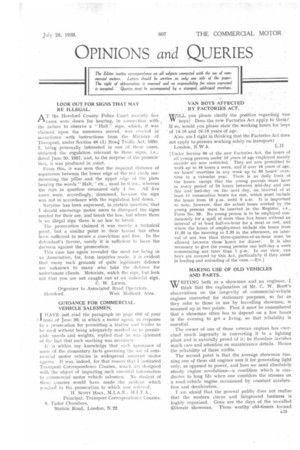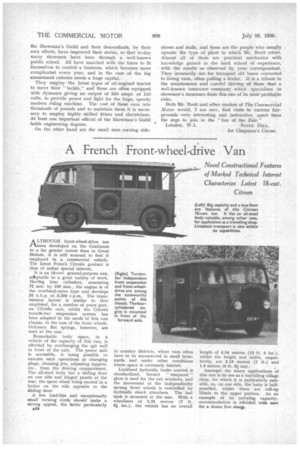OPINIONS and QUERIES
Page 43

Page 44

If you've noticed an error in this article please click here to report it so we can fix it.
The Editor invites correspondence on ll subjects connected with the use of com mercial motors. Letters should be written on only one side of the paper. The right of abbreviation is reserved and no responsibility for views expressed . is accepted. Queries must be accompanied by a stamped, addressed envelope.
LOOK OUT FOR SIGNS THAT MAY ' BE ILLEGAL.
AT the Hereford County Police Court recently five cases were down for hearing; in connection with the failure to observe a " Halt " sign, which, it was claimed upon the Summons served, was erected in accordance with instructions from the Ministry of Transport, under Section 48 (1) Road Traffic Act, 19:10. 1, being personally Interested in one of these cases, obtained the regulation relevant to these signs, i.e., dated June 30, 1937, and, to the surprise of the prosecution, it was produced in court.
From this, it was seen that the required distance of separation between the lower edge of the red circle surmounting the pillar and the upper edge of the plate bearing the words "Halt," etc., must be ti ins., whereas the sign in question measured only 4 ins. All five cases were, • accordingly, dismissed, because the sign was not in accordance with the regulation laid down.
Surprise has been expressed, in certain quarters, that I should encourage motor users to disregard the signs erected for their use, and break the law, but where there is an illegal sign there is no law to break.
The prosecution claimed it was merely a technical point, but. a similar point in their favour has often been sufficient to secure a conviction and fine. In the defendant's favour, surely it is sufficient to have the decision against the prosecution: This case has again revealed the need for being in an Association, for, from inquiries made, it is evident that many such grounds of quite legitimate defence are unknown to many who take the defence for unfortunate clients. Motorists, watch the sign, but look out that you are not caught out at an unlawful sign.
C. W. Ltwis, Organizer to Associated Road Operators, Hereford. West Midland Area.
GUIDANCE FOR COMMERCIAL. VEHICLE SALESMEN.
I
HAVE just read the paragraph on page (3(36 of your HAVE just read the paragraph on page (3(36 of your issue of June 30, in which a motor agent, in response to a prosecution for permitting a tractor and trailer to be used without being adequately marked as to permissible speeds and weights, replied that he was ignorant of the fact that such marking was necessary, IL is within my knowledge that such ignorance of some of the elementary_ facts governing the use of commercial motor vehicles is widespread amongst motor agents. It was, indeed, for that reason that 1 instituted Transport Correspondence Courses, which are designed with the object of imparting such essential information to commercial motor vehicle salesmen. No student of these courses would have made the mistake which resulted in the prosecution to which you referred, H. Scorr HALL, M. I. A . E , M.T.T.A., Principal, Transport Correspondence Courses. (3, Tudor Chambers, Station Road, London, N.22. VAN BOYS •AFFECTED BY FACTORIES ACT. •
WILL you ilease clarify the position regarding van TV boys? Does the new Factories Act apply to them? If so, would you please state the Working hours for boys
of 14-16 and 16-18 years of age. • • Also, am I right in thinking that the Factories Act does not apply to persons working solely on ,transport?
London, N.W.4. L.H.
[Under Section 98 of the new Factories Act, the hours of all young persons under 18 years of age employed mainly outside are now restricted. They are now permitted to work up to 48 hours a week, and if over 16 years of age, six hours' overtime in any week up to 50 hours' overtime in a calendar year. There is no daily limit of the hours, except that the young person's must have in every period of 24 hours between mid-day and one day and mid-day on the next day, an interval of at least 11 consecutive hours for rest, which must include the hours from 10 p.m. until 6 a.m. It is important to note, however, that the actual hours worked by the young persons must be inserted in the Register, i.e., Form No. 38. No young person is to be employed continuously for a spell of more than five hours without an interval of at least half-an-hour for a meal or rest, and where the hours of employment include the hours from 11.30 in the morning to 2.30 in the afternoon, an interval of not less than three-quarters-of-an-hour must be allowed between these hours for dinner. It is also necessary to give the young persons one half-day a week commencing not later than 1 p.m. In our view, van boys are covered by this Act, particularly if they assist in loading and unloading of the vans. —En.] •
MAKING USE OF OLD VEHICLES AND PARTS.
WRITING both as a showman and an engineer, I " think that the explanation of Mr. C. W. Brett's observations on the longevity of commercial-vehicle engines converted for stationary purposes, so far as they refer to those in use by travelling showmen, is summed up in two points. First it must be remembered that a showman often has to depend on a few hours in the evening to get a living, so that reliability is essential,
The owner of one of these veteran engines has exercised much ingenuity in converting it to a lighting plant and is naturally proud of it; he therefore lavishes much care and attention on maintenance details. Hence the reliability of these outfits.
The second point is that the, average showman running one of these old engines uses it for generating light only, as opposed to power, and here we need absolutely steady engine revolutions—a condition which is conducive to long life when one considers the stresses on • a road-vehicle engine occasioned by constant acceleration and deceleration., am afraid' that the general public does not realize that the modern circus and 'fairground business is highly organized. Gone are the days of the so-called illiterate showman. These worthy' old-timers formed The Showman's Guild and their descendants, by their own efforts, have improved their status, so That to-day many showmen have been through a well-known public school. All have marched with the times to fit themselves to control a business, which becomes more complicated every year, and in the case of the big amusement caterers needs a huge capital.
They employ the latest types of oil-engined tractor to move their "tackle," and these are often equipped with dynamos giving an output of 350 amps. at 110 volts, to provide power and light for the huge, speedy modern riding machine. The cost of these runs into thousands of pounds and to maintain them it is necessary to employ highly skilled fitters and electricians. At least one important official of the Showman's Guild holds engineering degrees.
On the other hand are the small men owning side shows and stalls, and these are the people who usually operate the type of plant to which Mr. Brett refers. Almost all of them are practical mechanics with knowledge gained in the hard school of experience, with the results as observed by your correspondent. They invariably use for transport old buses converted to living vans, often pulling a trailer. It is a tribute to the maintenance and careful 'driving of these that a well-known insurance company which specializes in showmen's insurance finds this one of its most profitable risks.
Both Mr. Brett and other readers of The Commercial Motor would, I am sure, find visits to various fairgrounds very interesting and instructive, apart 'from the urge to join in the "fun of the Fair."
London, W.1. STEVE HILL, for Chapman's Circus.












































































